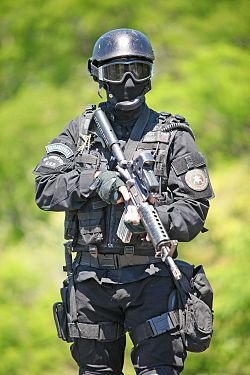Batalhão de Operações Policiais Especiais (PMERJ)

Batalhão de Operações Policiais Especiais (Portuguese for "battalion for special police operations", BOPE for short ) refers to the special units of the Brazilian military police in the state of Rio de Janeiro ( Polícia Militar do Estado do Rio de Janeiro ).
Due to the nature of the crime in the favelas , the BOPE units have extensive experience in urban warfare. They use heavier armament and tougher methods to carry out their tasks than the normal police in Rio de Janeiro. This is due to criminal organizations such as the Comando Vermelho, which are also equipped with weapons of war . 400 police officers are currently on duty at BOPE.
History and origin
The origin of the BOPE lies in the Núcleo da Companhia de Operações Especiais (core of the special operations company, NuCOE for short), which was founded on January 19, 1978 and was placed under the command of the Chief of Staff of the Military Police. In 1982 the company was affiliated with the Batalhão de Polícia de Choque and the organization was renamed Companhia de Operações Especiais ("Company for Special Operations", COE). In 1984 the name was changed again to NuCOE and was again under the command of the Chief of Staff. In 1988 the Companhia Independente de Operações Especiais ("Independent Company for Special Operations", CIOE) was founded. The jurisdiction covered the entire state of Rio de Janeiro. On March 1, 1991, the name was changed to Batalhão de Operações Policiais Especiais (BOPE for short).
Areas of responsibility
- Additional security deposit for special events and events
- Breaking the barricades of drug traffickers
- Killing criminals who endanger human life
- Destruction of drug ghettos and their gangs
- Rescuing or rescuing police officers or civilians wounded in confrontations
- Rescuing police officers or civilians trapped or endangered by gunfire
- Execution of risky arrest warrants
- Hostage Liberations
- Calming the situation in connection with rampages
- Suppression of prison revolts
- Support the police
- Providing superior firepower when attacking in certain situations
- armed patrols
- special missions in swamps or mountainous terrain such as exploration, planning and infiltration
- Fight against crime
- Solving high risk situations with a minimum of dead, wounded and property damage
- Combating heavily armed criminals
Weapons and vehicles
The unit has a fleet of military vehicles known as the Pacificador ( Bringer of Peace) or Caveirão ("Big Skull"). These vehicles are used in the favelas, where there are violent clashes between the BOPE and drug trafficking gangs. BOPE soldiers are equipped with heavy armament:
- M16 A2 assault rifle
- M4 A1 machine carbine
- M1 semi-automatic rifle
- H&K PSG1 ( sniper rifle 1)
- Benelli M3 shotgun
- FN P90
- IMBEL MD2 , a Brazilian assault rifle (Indústria de Material Bélico do Brasil)
- H&K MP5 A2 and K submachine gun
- H&K G3 assault rifle
- H&K 21 machine gun
- Taurus PT92 semi-automatic pistol
- IMBEL 9mm
- C-4 explosives
- Hand grenades
- FN FAL
- knife
Tropa de Elite
In 2006 the book Elite da Tropa was published. It was written by the sociologist Luiz Eduardo Soares with the assistance of two former BOPE officers , Major André Batista and Captain Rodrigo Pimentel. The author took into account the daily routine of the BOPE as well as some historical events based on the experiences of the ex-officers. In the course of the book, the unit is described as sometimes rigorous in its approach. In addition, it is about naming some details of an alleged failed assassination attempt by police officers on the then governor Leonel Brizola . At the time of its publication, the book was controversial, especially in police circles, due to the hardships of everyday work and the questionable truthfulness of individual accusations. The book was filmed as Tropa de Elite by José Padilha and was awarded the Golden Bear for best film at the Berlinale .
criticism
Since 2006, Amnesty International has explicitly condemned the use of the caveirão , stating that the use of the vehicle is emphatically aggressive and confrontational and, in connection with its use as a mobile command post, not only raises questions about its effectiveness against crimes in the favelas. Reports of excessive use of force and murder of innocent passers-by were loud.
Individual evidence
- ^ Campanha Contra o "Caveirão" . Justiça Global. Archived from the original on August 20, 2008. Retrieved September 19, 2008.
- ↑ Lasterra, Juan Pablo (2008). "La Police Militaire Brésillienne en état de Guerre" (in Spanish). Police Pro No. 11 (September 2008).
- ^ Mario Hugo Monken: Livro sobre elite da PM do Rio causou punição, diz author . Folha de S. Paulo . April 29, 2006. Retrieved September 5, 2007.
- ↑ Golden Bear for "Tropa de Elite" , FAZ.NET , February 16, 2008.
- ↑ Brazil's caveirão: "What are you most afraid of?" (PDF; 129 kB) Amnesty International. April 11, 2006. Archived from the original on July 2, 2014. Retrieved January 17, 2013: “The caveirão ('big skull') is a military-style assault vehicle used to police Rio de Janeiro's favelas. It targets socially excluded communities, increasing violence and criminalizing poverty. Between May and September 2005, 11 people were killed in caveirão-led operations. The caveirão is part of a pattern of confrontational and intimidating policing. It targets socially excluded communities, increasing violence and criminalizing poverty in Rio. "
See also
Web links
- PMERJ - Polícia Militar do Estado do Rio de Janeiro, BOPE (official website of the BOPE of the State of Rio de Janeiro, Portuguese)
